On May 3, demolition will begin on the Colorado Judicial Building at 14th and Broadway in Denver’s Civic Center district to make way for the new Ralph L. Carr Colorado Judicial Complex. Perhaps the most prominent feature of the existing judicial building is the mural entitled Justice Through the Ages by notable Colorado artist Angelo di Benedetto (1913-1992) that graces the underside of the building as it spans over the plaza and the skylights that look down into the building’s law library.
Since I posted my blog about the Judicial Building and the mural in February, people have asked me what is going to happen to the mural when the building is demolished. I didn’t know the answer to that question until now, thanks to an excellent article by Matt Masich posted on March 10th in Law Week Colorado. The answer (and the good news): the mural will be saved and put in storage for the time being. The problem is no one quite knows what to do with it. Some people are advocating for it to be installed somewhere in the new Judicial Complex, but the challenge is the mural’s size. If laid out in one long row, the mural’s 74 panels would stretch 100 yards, and there’s no place in the new Judicial Complex that long to accommodate the mural, and no one seems to like the idea of breaking the mural up and installing the panels in different locations. Anyway, please read Matt’s article as it contains a lot of interesting information about the artist, the mural, and its future. Use the link above or click here for a PDF of the article.
Since the mural will be removed soon from public view and put in storage for who knows how long, I feel it is my civic duty to provide an online commemoration of the mural for people to enjoy after its removal. Also, there’s no plaque in the plaza that tells you who the 60 individuals are on the mural but, thanks to a state law librarian who dug around and found for me a document with that information, I’m happy to provide the names of those honored on the mural as part of this effort.
All of the names, dates, and biographical information presented below is quoted from a publication called Colorado Courts, a monthly newsletter issued by the Colorado Judicial Department back in the 1970s. The feature about the people in the mural followed the mural’s October 1978 dedication, and was spread across several issues of Colorado Courts, starting in December 1978 and concluding in April 1979 (catalog reference “The Mural” – KFC2308.A16 C66 – “Colorado Courts” – Dec. 1978, Jan.-Feb. 1979, March 1979, and April 1979). According to the article’s final installment, the authors of the biographical information below include Angelo di Benedetto, Don Cherno, Otto and Helen Friedrichs, Robert Dallenbach, the Denver, Westminster, and Adams County libraries, Astrid Galindo of the Mexican Consulate, Stephanie Albo, Terry Goldhammer, and Karoline Freed Briggs, and others. The photos, of course, are by me.
Without further ado, Justice Through the Ages (from left to right):
Hammurabi (18th Century BC) – King of Babylon and famous for code of laws
Akhenaton and wife Nefertiti (1375 BC) – King of Egypt and reformer
Moses – Hebrew lawgiver, Ten Commandments
Deborah (1100 BC) – a judge in Israel
Solon (5th Century BC) – Athenian statesman and lawgiver of Athens
Aspasia (470-410 BC) – Influential woman of Athens, associate of Pericles
Artistotle (384-322 BC) – pupil of Plato and philosopher
Plato (427-347 BC) – Greek philosopher
Socrates (470-399 BC) – Anthenian philosopher
Homer (8th Century BC) – Greek epic poet
Justinian the Great (483-565 AD) and Empress Theodora – Roman emperor who codified Roman law
Cicero (106-43 BC) – Greatest Roman orator and unsurpassed master of Latin prose
Tribonian (500-547 AD) – Roman jurist who directed compilation of Corpus Juris Civilis
Gaius (130-180 AD) – Second century Roman jurist known for the Institutes, a legal textbook
Papinian (142-212 AD) – Jurist, perhaps the greatest figure of Roman law
Ulpian (c. 170-228 AD) – Roman jurist and author of Libri ad edictum
Francisco Jose De Goya Y Lucientes (1746-1828) – Spanish painter and graphic artist, social satirist outraged at war and corruption
John Marshall (1755-1835) – noted American jurist, fourth Chief Justice of the United States who molded the Constitution by the breadth and wisdom of his interpretation
Alexander Hamilton (1755-1804) – American statesman, Secretary of the Treasury under George Washington, author of law papers recently published, most powerful of the Federalists
John Adams (1735-1826) – Second President of the United States, lawyer, leader in the American Revolution, and prolific writer
James Madison (1751-1836) – Fourth President of the United States, master builder of the Constitution and strong advocate of the Bill of Rights
Benjamin Franklin (1706-1790) – American statesman, printer, scientist, inventor, and writer influential in drafting the Constitution
Thomas Paine (1737-1809) – Anglo-American political theorist and writer, strong supporter of the American Revolution and author of the Rights of Man
Philip Mazzei (1730-1816) – Italian physician, merchant, horticulturist and author, close friend of Thomas Jefferson and the latter’s personal ambassador to sell democracy to Europe, may have written the first line of the Declaration of Independence
Thomas Jefferson (1743-1826) – Third President of the United States, author of the Declaration of Independence, architect, scientist, philosopher and statesman
Josefa Ortiz De Dominguez (1768-1829) – Wife of the Corregidor (Mayor) of Queretaro, and sponsor of home meetings in favor of Mexican independence, leading to the War of Independence in 1810
Miguel Hidalgo Y Costilla (1753-1811) – Mexican priest and revolutionary, national hero, Creole intellectual who helped natives improve their lot but was defrocked and shot
Jose Maria Marelos Y Pavou (1765-1815) – Liberal Mexican priest acclaimed a hero, joined the revolution against Spain and assumed leadership upon Hidalgo’s execution and subsequently suffered the same fate
Benito Pablo Juarez (1806-1872) – Mexican statesman, lawyer and national hero, an Indian, Minister of Justice and acting president—the border city of Juarez bears his name
Mary Wollstonecraft (1759-1797) – English author and feminist who promoted educational equality and was close to leaders of the French Revolution—she died in childbirth; her daughter Mary married Percy Bysshe Shelley
Emmaline Goulden Pankhurst (1858-1928) – British woman suffragist, nationally revered, founded the Woman’s Social and Political Union; after World War I moved to Canada, returned to England in 1925 and died campaigning for Parliament
Abraham Lincoln (1809-1865) – 16th President of the United States, the great emancipator, most memorialized American figure, savior of the Union, lawyer, statesman of noble vision, humanity and political wisdom, assassinated at close of the Civil War
Sojourner Truth (1797-1883) – A freed slave who responded to “heavenly voices” and traveled throughout the North, effectively preaching abolition, emancipation and women’s rights
Frederick Douglass (1817-1895) – American abolitionist, son of a Negro slave, editor of the North Star, author, advocate of civil rights, government officer and minister to Haiti
Harriet Tubman (1820-1913) – Negro slave, “conductor” on the Underground Railroad, friend of the principal abolitionists, confidant of John Brown, nurse and spy for the Union forces
Susan B. Anthony (1820-1906) – American reformer and leader of the woman-suffrage movement, organizer of temperance movements, historian, foremost advocate of women’s rights to franchise
Elizabeth Cady Stanton (1815-1902) – Reformer, woman suffrage leader, organizer of women for equality, writer, orator, editor of a militant feminist magazine published by Susan B. Anthony
Abigail Scott Duniway (1834-1915) – Editor, lecturer and an unceasing champion of women’s rights, recognized as leader of the women’s movement in the Northwest
Jane Addams (1860-1935) – Social worker, founder of Hull House in Chicago, active reformer, leader in suffrage and pacifist movements, author, influential in civic affairs, recipient of the Nobel Peace Prize
Alice Paul (1883-1977) – Social reformer, one of the founders and later chair of the National Women’s Party, sponsor of the first equal rights amendment introduced in Congress in 1923
Sarah Winnemucca (1844-1891) – A woman of the Paviotso, daughter of the Chief, interpreter and scout, teacher, lecturer and author, advocate for her people
Joseph (1840-1904) – Nez Perce chief, intercedes with President Rutherford B. Hayes (1822-1893) and two Congressmen. Chief Joseph was a symbol of the heroic Nez Perce retreat which has been compared to that of Xenophon’s ten thousand. President Hayes, a lawyer and Civil War general, served in Congress and as Governor of Ohio. After the presidency, he was noted for efforts in prison reform
Mandarin Sun Yat-Sen (1866-1925) – Physician, student of Western political theory, Chinese revolutionary, first provisional president of the Chinese Republic (1911) and later president of a self-proclaimed national government at Canton (1921)
Soong Ching-Ling (1893-1981) – Wife of Mandarin Sun Yat-Sen, political activist, writer, recipient of the Stalin Peace Price, Vice-Chairman of the People’s Republic (1949)
Mohandas Karamchand Gandhi (1869-1948) – Indian spiritual and political leader, successful lawyer, leader of civil disobedience, prominent in achievement of independence for India, assassinated by Hindu fanatic—accompanied here by an unnamed disciple
Clarence Seward Darrow (1857-1938) – American lawyer, renounced lucrative corporate practice to defend the “underdog”, most famous for the Leopold and Loeb defence and Scopes evolution trial
Franklin Delano Roosevelt (1882-1945) – 32nd U.S. President, Assistant Secretary of the Navy, Governor of New York, lawyer, reformer, father of the New Deal, influential international figure in World War II
Eleanor Roosevelt (1884-1962) – American humanitarian, active in social betterment, leader in women’s organizations and youth movements, promoter of consumer welfare and civil rights
Martin Luther King, Jr. (1929-1968) – American clergyman and civil rights leader, organizer of the Southern Christian Leadership Conference, recipient of Nobel Peace Prize, killed by an assassin’s bullet
John Fitzgerald Kennedy (1917-1963) – 35th U.S. President, World War II naval hero, congressman and senator from Massachusetts, eloquent advocate of social justice and international accord, assassinated in Dallas.
Earl Warren (1891-1974) – 14th Chief Justice of the United States, Attorney General and Governor of California, liberal and dynamic leader in the area of landmark decisions in civil rights and individual liberties
========
These last three photos show the artist’s name, the names of his assistants, and the mural’s center design:
Let’s hope the mural finds a new home soon.

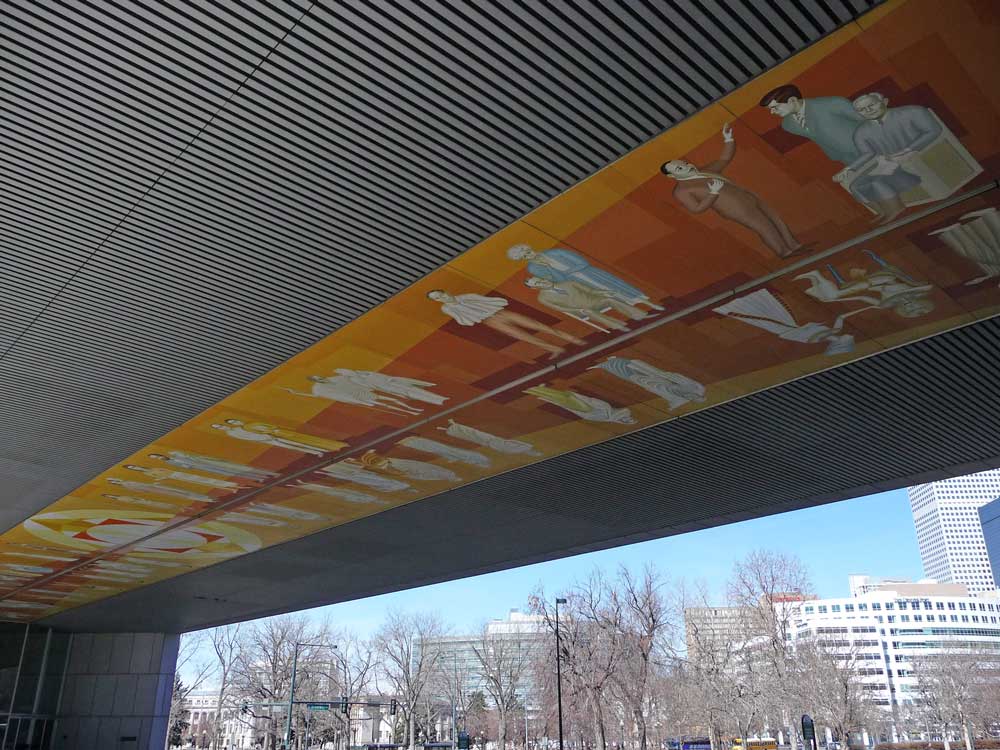


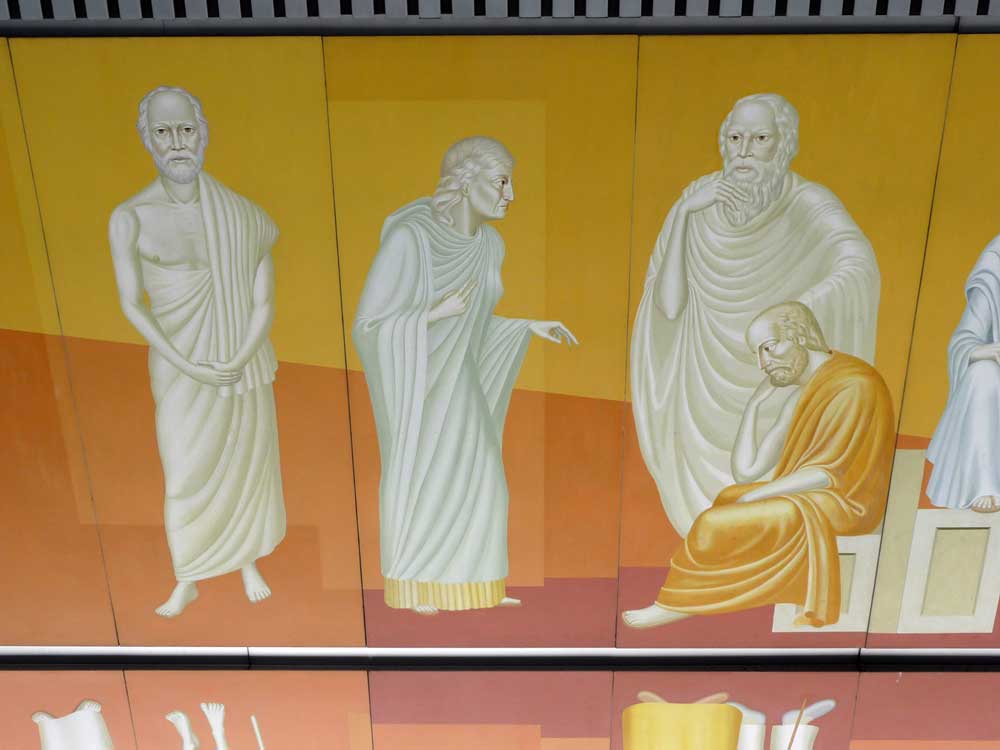
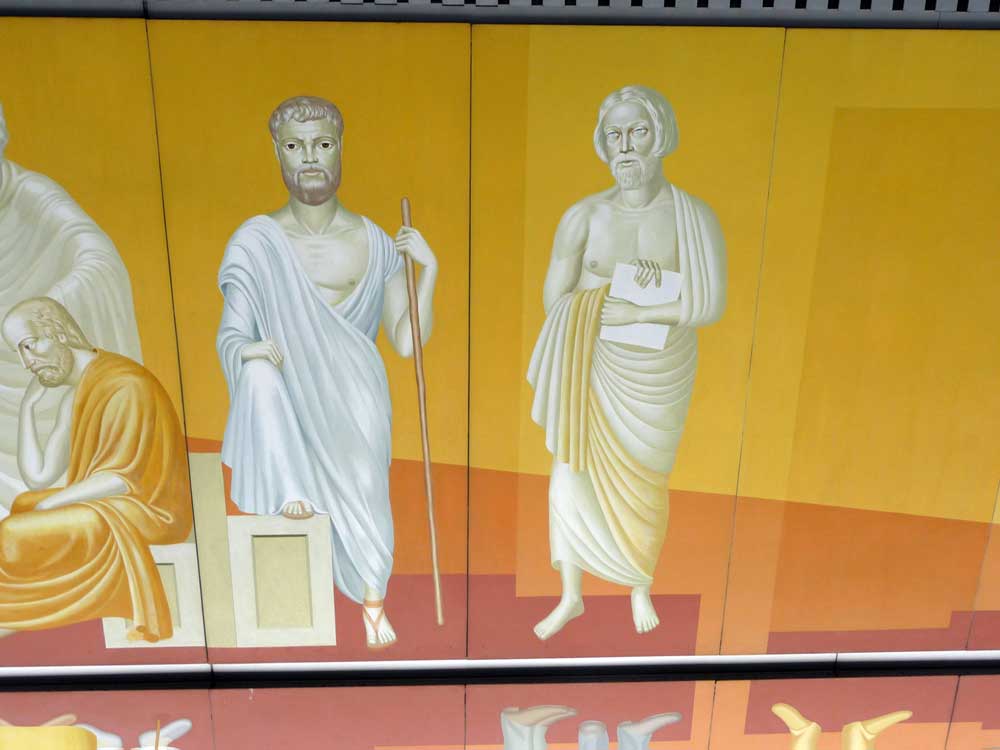
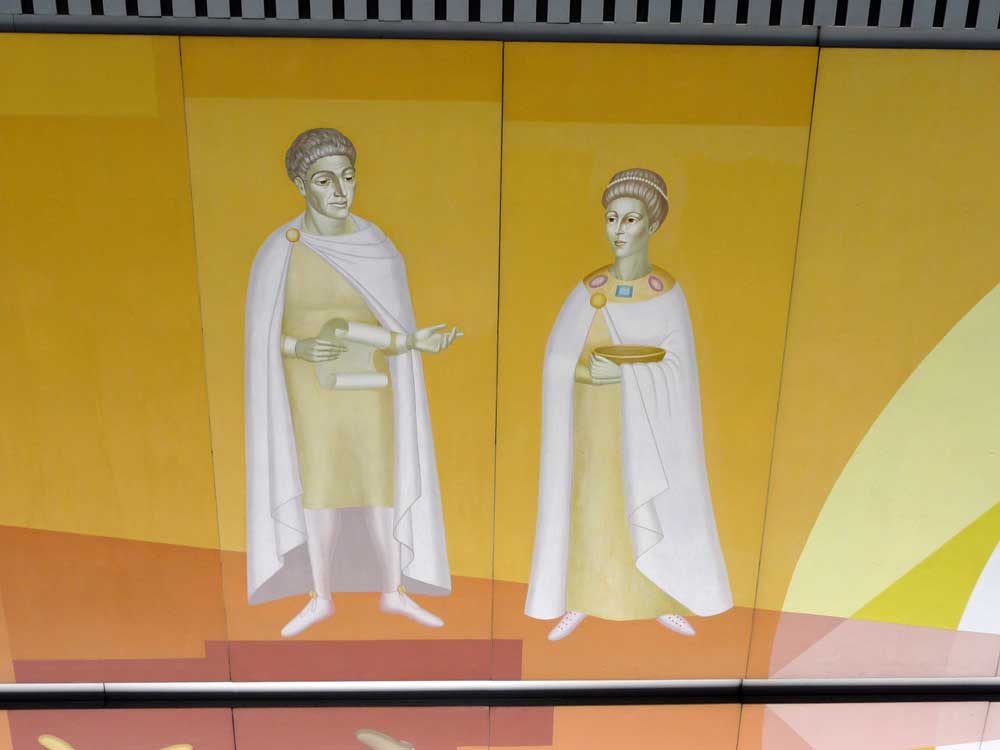



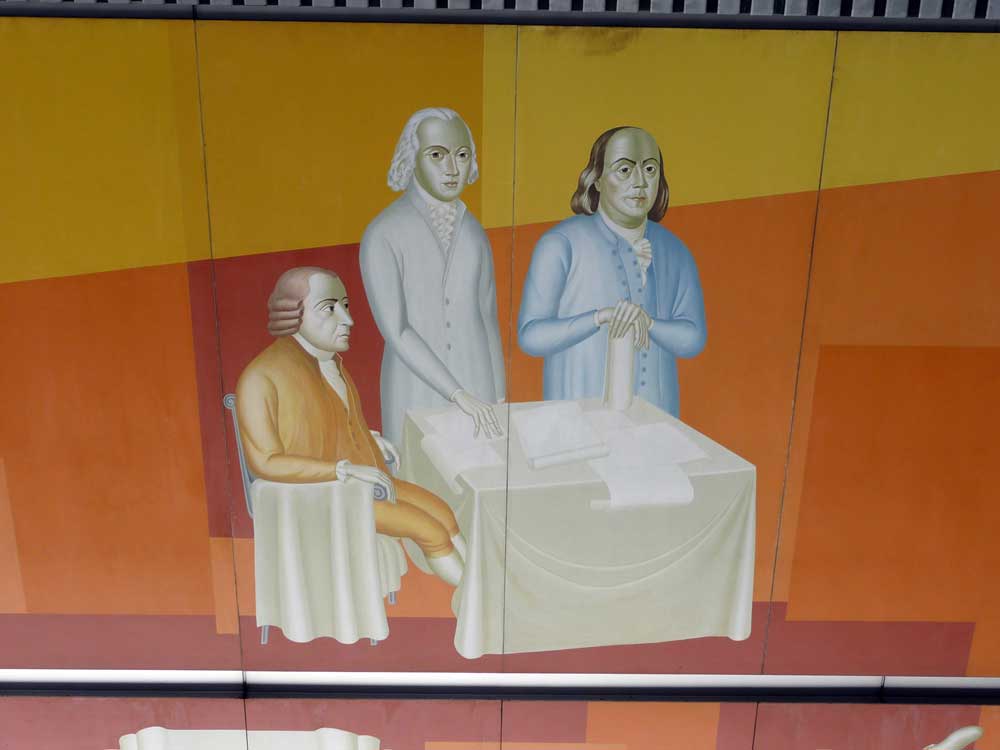
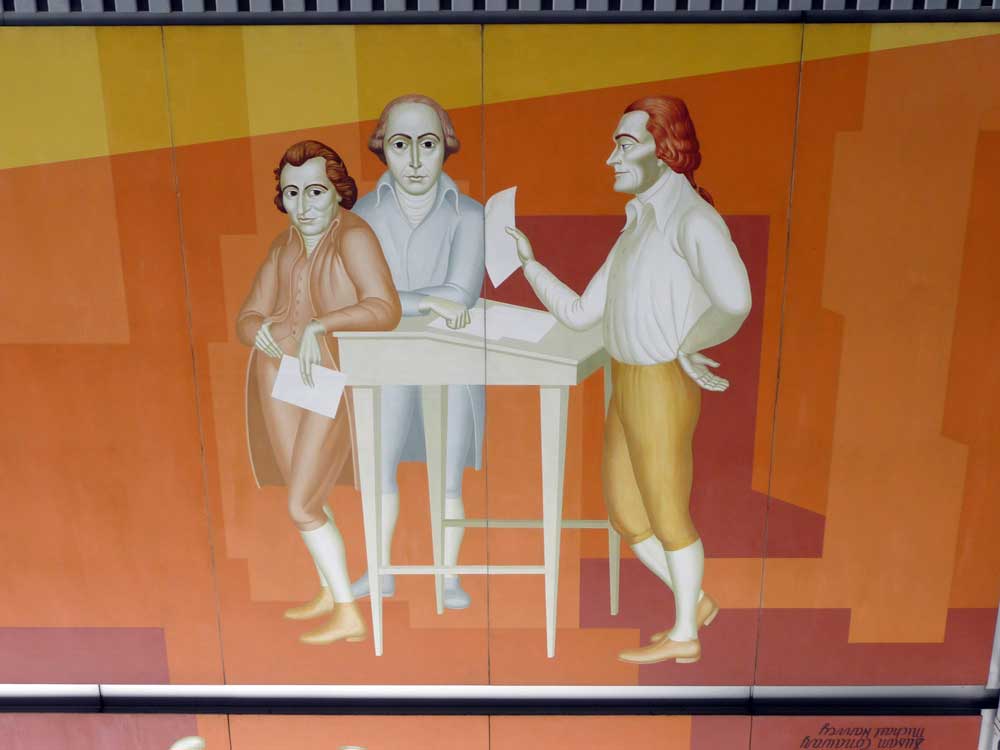






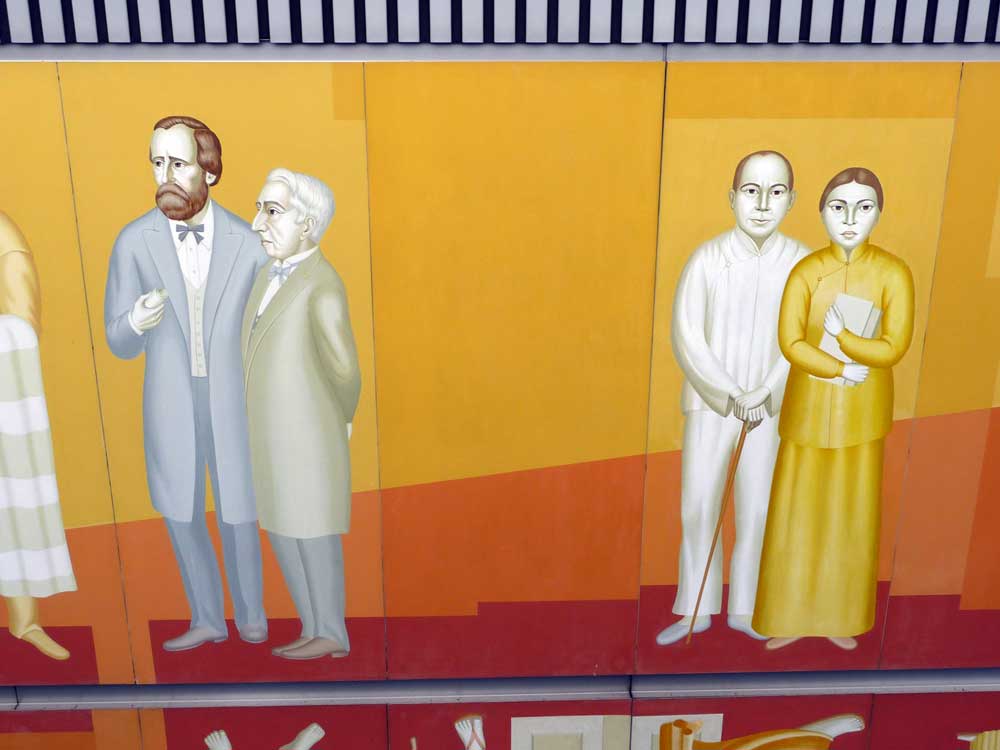


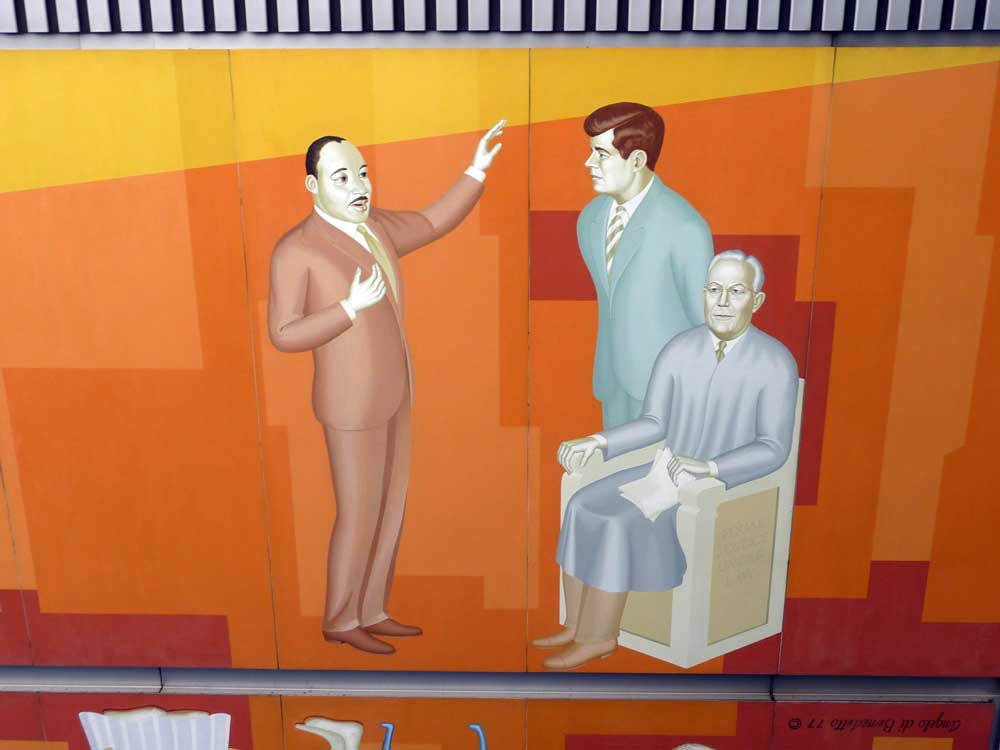










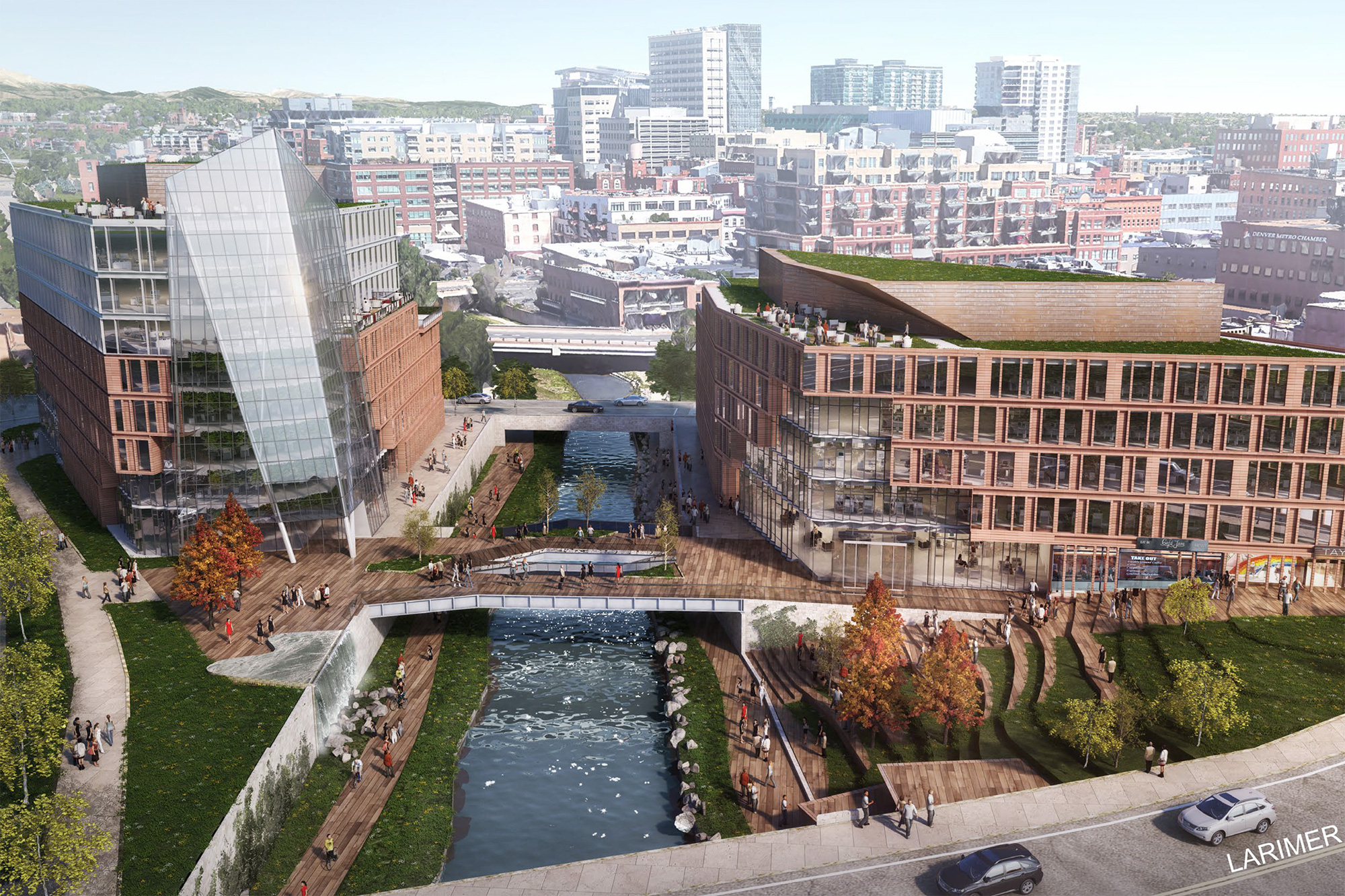

Great post, I’m glad that you took the time to preserve the memory of this work. Very beautiful piece.
Although I already know the answer, could the new city justice center use the piece? Are there any walls long enough? Or what about the new state history museum? Thank you for all the history!
This commemoration is extraordinary!! I wish my grandmother (Angelo’s sister) were alive to see how thoughtful you were in capturing his work for so many to enjoy. She would have sent the nicest hand written letter thanking you.
Why not encase it within a protective glass casing and mount it outside – potentially between the sidewalk and the building. Make it a “public” exhibit that pedestrians can stop and examine – kind of like those signs posted along trails describing local fauna. I love those things!
WOW. Thanks for this wonderful post! I hope the mural can somehow be incorporated into either the new judicial building or the new state history museum.
So not much happened between 170 and 1746…
Actually Ralph nothing much happened after the end of Justinian’s reign in 565 during the Roman era. A plague wiped out half of the population of both the Eastern Roman Empire and Persia about that time.
The timeline above is a little confusing, it jumps around during the Roman period.
When you are standing outside looking up at the mural you can look down on the edge of the skylite and there is a plaque that tells you who the person is above you.
I should add that I think that is a beautiful and inspiring mural and I hope if finds a home in the new justice center.
I think we will regret tearing down this building. It’s very unique. There are plenty of surface lots where a new justice center could have been built.
Thanks, Ginger. I never noticed that.
I love this blog, reading it is usually the best part of my day/week! I’m not sure what the mural is made of but at the very least, they should install it inset in the new sidewalk when they build the new building, or inset in the new Colorado History Building sidewalk (I can’t bring myself to call it History Colorado, it’s not proper english). This would allow them to keep it together and visibility would be increased greatly. I hope Coloradoans are able to enjoy it for years to come. Thanks Ken for another great post!
Nice item, thx. But I think the 5th century BC Athenian lawgiver’s name was Solon, not Salon.
So very interesting. The redevelopment of this block breaks my heart as much as excites me. Mixed emotions. These are two of my favorite buildings. I wish they could be relocated instead of torn down. Is it too late?
I like the idea of making it an outside display so that everyone can see it.
The 12 century gap is interesting. The biggest intervening individuals in legal history would be:
1. Norman the Conqueror who established the English common law system in 1066.
2. Someone involved in the Magna Carta (1215), perhaps King John who assented to it first, or King Henry I whose Charter of Liberties (1100) it was based upon almost word for word.
3. Sir Edward Coke (1552–1634) who extended magna carta rights from the aristocracy to commoners.
wp. You’re right, it’s Solon. That was a typo on my part. Thanks for the correction. All fixed.
Perhaps one idea for (maybe somewhat temporary) a location – the exposed precast concrete on the Cultural Center Parking Garage – facing Broadway…..it would bring some animation, color, and history to a very bland facade….
Although the mural is state property, it might work as decoration for the long, long underground corridor that will connect the new Denver Detention Facility with the Courthouse. It would be very symbolic for those that work there (and those who are appearing before a judge), but, unfortunately, it would not be accessible to the general public.
Interesting missing people:
Emperor Napoleon I — in whose name civil law was codified in France and throughout the civil law countries — the Napoleonic Code is still the basis for much civil law jurisprudence, including in Louisiana.
Sir William Blackstone, who wrote the classic view of the Common Law in the 1700 — “Commentaries on the Laws of England” – basis for much of the classic jurisprudence on which the general American system of justice is based.
Couple other bits of trivia:
The English King in 1066 is “William the Conqueror,” who was Duke of Normandy and therefore a “Norman,” who presided over the “Norman Conquest.”
Mary Shelly (Mary Wollencraft’s daughter) is also, of course, famous as the author of the novel “Frankenstein.”